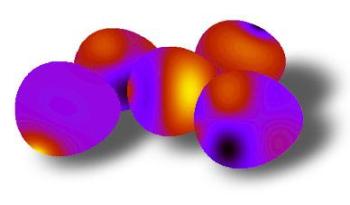National Institute of Standards and Technology (NIST) researchers recently colored batches of egg shaped nano-particles to enable energy efficient computer memories.
The team utilized electron-beam lithography to create nickel-iron magnets measuring 200nm in diameter that resembles an ellipse. Magnets in three egg like shapes with more pronounced ends were used.
 Simulated magnetic patterns in NIST’s egg-shaped nanoscale magnets
Simulated magnetic patterns in NIST’s egg-shaped nanoscale magnets
The team discovered that minute distortions in the magnet shape could alter magnetic properties by analyzing the magnets with a laser and the reactions to electron spins, a quantum property causing magnetic orientation. Spin alterations could flow through the magnet at multiple frequencies. The more the magnet resembles an egg, the more complicated were the wave patterns and frequencies, with the changes more visible at the ends.
The team simulated different magnets with object-oriented micromagnetic framework (OOMMF) of NIST. Light colors show strong frequency signals.
The research analyzed the behavior patterns of large arrangements of nanomagnets, which could be imperfectly shaped due to lithography. Imperfections like these could impact changes in magnetic devices. The research could help develop random-access memories (RAM) based on communication between electron spins and magnetized surfaces.
NIST physicist, Tom Silva said intended distortion in spin RAM memory elements could lead to reliable switching.